What constitutes a ‘document’ and how does it function?
According to the Oxford English Dictionary, the etymological origin is the Latin ‘documentum’, meaning ‘lesson, proof, instance, specimen’. As a verb, it is ‘to prove or support (something) by documentary evidence’, and ‘to provide with documents’. The online version of the OED includes a draft addition, whereby a document (as a noun) is ‘a collection of data in digital form that is considered a single item and typically has a unique filename by which it can be stored, retrieved, or transmitted (as a file, a spreadsheet, or a graphic)’. The current use of the noun ‘document’ is defined as ‘something written, inscribed, etc., which furnishes evidence or information upon any subject, as a manuscript, title-deed, tomb-stone, coin, picture, etc.’ (emphasis added).
Both ‘something’ and that first ‘etc.’ leave ample room for discussion. A document doubts whether it functions as something unique, or as something reproducible. A passport is a document, but a flyer equally so. Moreover, there is a circular reasoning: to document is ‘to provide with documents’. Defining (the functioning of) a document most likely involves ideas of communication, information, evidence, inscriptions, and implies notions of objectivity and neutrality – but the document is neither reducible to one of them, nor is it equal to their sum. It is hard to pinpoint it, as it disperses into and is affected by other fields: it is intrinsically tied to the history of media and to important currents in literature, photography and art; it is linked to epistemic and power structures. However ubiquitous it is, as an often tangible thing in our environment, and as a concept, a document deranges.
the-documents.org continuously gathers documents and provides them with a short textual description, explanation,
or digression, written by multiple authors. In Paper Knowledge, Lisa Gitelman paraphrases ‘documentalist’ Suzanne Briet, stating that ‘an antelope running wild would not be a document, but an antelope taken into a zoo would be one, presumably because it would then be framed – or reframed – as an example, specimen, or instance’. The gathered files are all documents – if they weren’t before publication, they now are. That is what the-documents.org, irreversibly, does. It is a zoo turning an antelope into an ‘antelope’.
As you made your way through the collection,
the-documents.org tracked the entries you viewed.
It documented your path through the website.
As such, the time spent on the-documents.org turned
into this – a new document.
This document was compiled by ____ on 03.06.2023 07:28, printed on ____ and contains 16 documents on _ pages.
(https://the-documents.org/log/03-06-2023-5356/)
the-documents.org is a project created and edited by De Cleene De Cleene; design & development by atelier Haegeman Temmerman.
the-documents.org has been online since 23.05.2021.
- De Cleene De Cleene is Michiel De Cleene and Arnout De Cleene. Together they form a research group that focusses on novel ways of approaching the everyday, by artistic means and from a cultural and critical perspective.
www.decleenedecleene.be / info@decleenedecleene.be - This project was made possible with the support of the Flemish Government and KASK & Conservatorium, the school of arts of HOGENT and Howest. It is part of the research project Documenting Objects, financed by the HOGENT Arts Research Fund.
- Briet, S. Qu’est-ce que la documentation? Paris: Edit, 1951.
- Gitelman, L. Paper Knowledge. Toward a Media History of Documents.
Durham/ London: Duke University Press, 2014. - Oxford English Dictionary Online. Accessed on 13.05.2021.

In Walter Benjamin’s The Arcades Project, Convolute Q is dedicated to the panorama. Benjamin writes: ‘Setup of the panoramas: View from a raised platform, surrounded by a balustrade, of surfaces lying round about and beneath. The painting runs along a cylindrical wall approximately a hundred meters long and twenty meters high. The principal panoramas of the great panorama painter Prévost: Paris, Toulon, Rome, Naples, Amsterdam, Tilsit, Wagram, Calais, Antwerp, London, Florence, Jerusalem, Athens. Among his pupils: Daguerre’ (Q1a, 1).
Benjamin, W. The Arcades Project (H. Eiland & K. McLaughlin, trans.). Cambridge/London: The Belknap Press of Harvard University Press, 2002, p. 528.
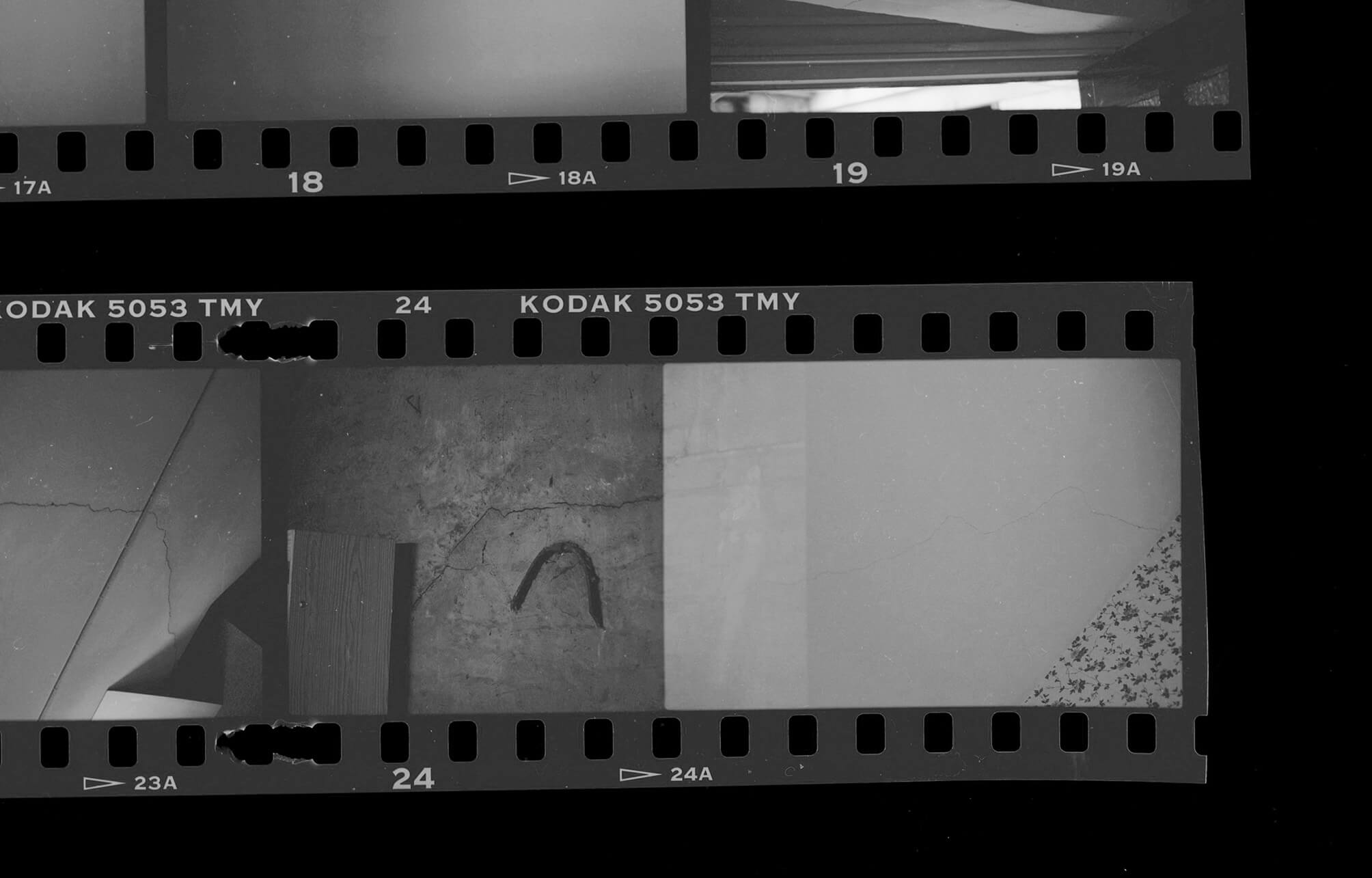
In 2020, the print versions of the Flemish telephone books ‘Gouden Gids’ and ‘Witte Gids’ (The Golden Guide and The White Guide), were published for the last time. From that year onwards, the directory could only be accessed and consulted online. The effect of the production of print telephone directories on the environment is considered to be enormous. As yearly updated, ubiquitous books, they were publications that soon turned superfluous. They led to piles of waste.
From the beginning of the 21st century on, both the print version and the online version had been available. This was a period of medium transition. During the last two decades, the print directory increasingly referred to the websites of the companies listed. To search for e.g. someone to inspect the heating installation, it was possible to find such a company’s website via the print directory, and consult the inspector’s services and price online, bypassing search engines such as Google and its complex algorithms. The telephone directory had a thematic and alphabetical order, combined with the possibility to buy additional advertising space.
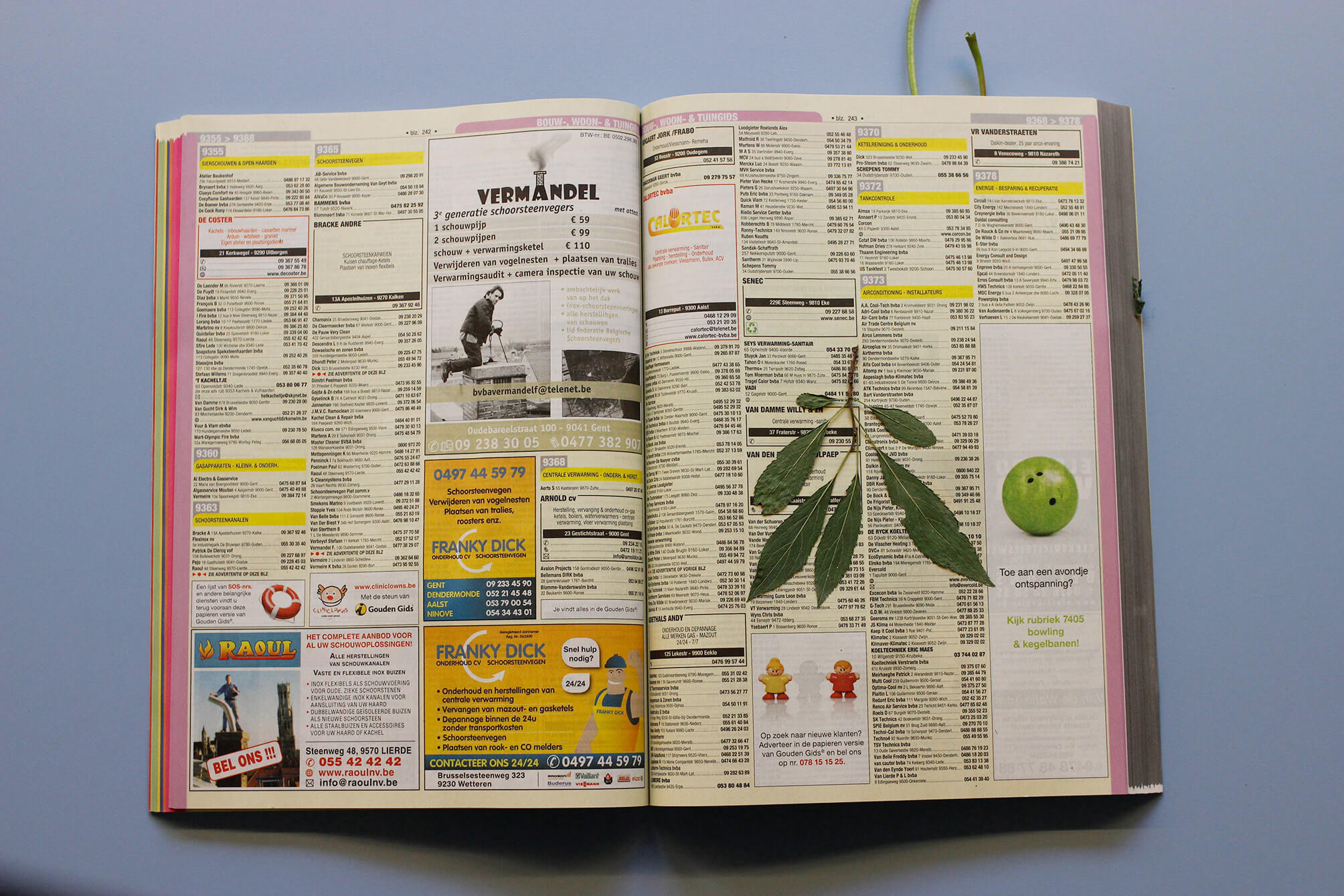
It’s early spring. The pool is covered with a sheet of plastic. The deciduous trees are just leafing out. A tree stump serves as a placeholder for the diving board’s foot – it was customary to take it indoors for winter – and keeps people from kicking its threaded rods sticking up from the silex tiles that line the pool.
The upper right corner of the plastic frame is missing. It’s probably where the insect – now dead, dry and yellowish – got in. The frame was left behind in the laundry room overlooking the garden, the pool and the pool house. At the time it hadn’t been used for quite a while. Half empty, the water green.
In summer, when the wind dropped, horse-flies came. You could shake them off temporarily by swimming a few meters underwater.

According to @missbluesette, the green K-10 put up for sale by Fred from Zwolle that I came across on marktplaats.nl on 29 September 2022 is not green, but blue. The colour resembles turquoise, I explain, a colour I have always called green. No, turquoise is not green, but blue, she replies. And the texts of my Instagram posts are too long, she says, so she doesn’t read them.
Lars Kwakkenbos lives and works in Brussels and Ghent (B). He teaches at KASK & Conservatorium in Ghent, where he is currently working on the research project ‘On Instructing Photography’ (2023-2024), together with Michiel and Arnout De Cleene.
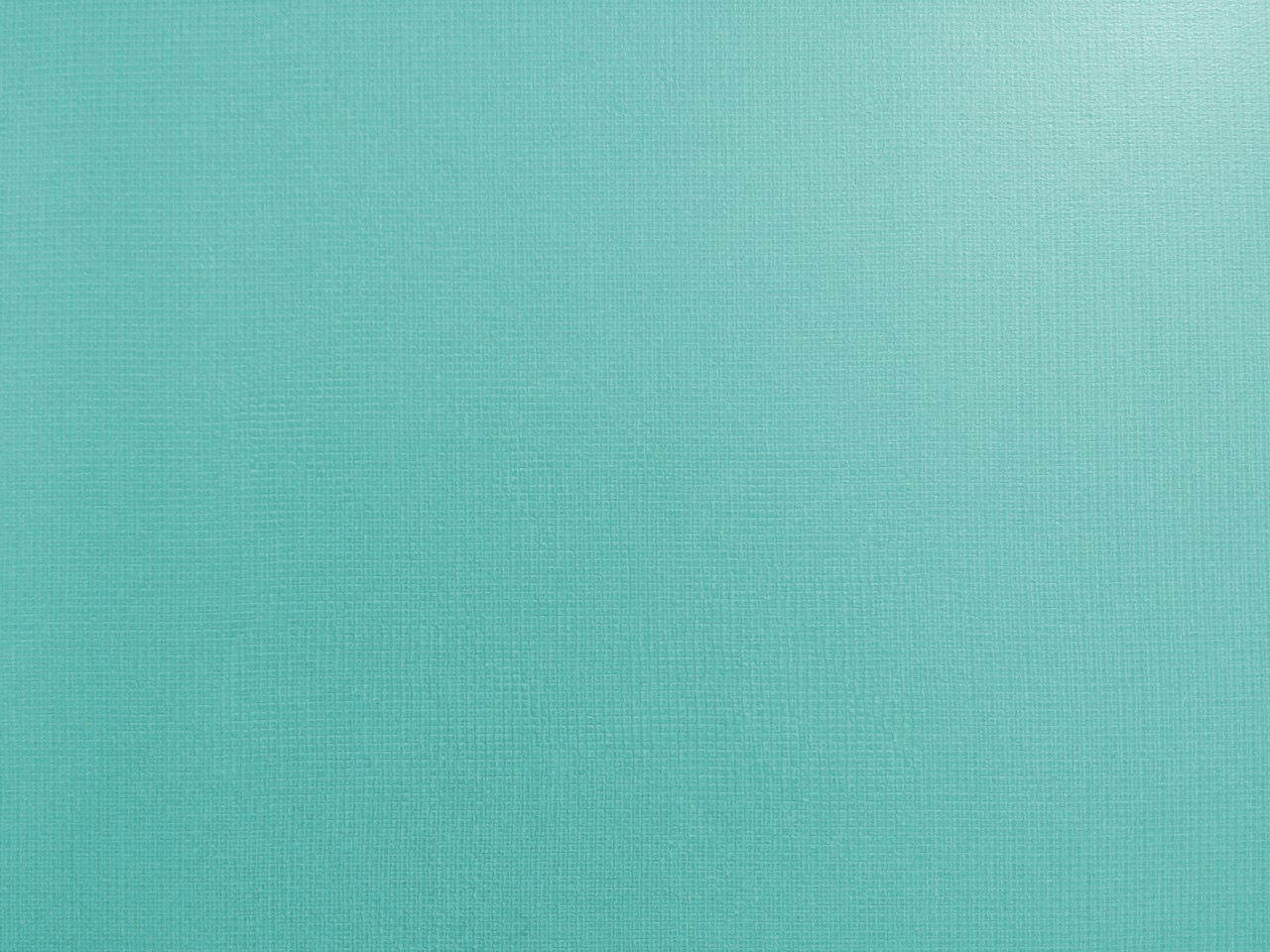
At a dental practice, the white Alligat®-powder is mixed with the right amount of water to get a mouldable dough that is pressed upon a patient’s teeth. After thirty seconds, the Alligat®-dough stiffens and takes on a rubber-like quality. At that point, still white, it must be removed from the patient’s mouth. Over the next few hours, the mould turns increasingly pink as the substance becomes less humid. Now, it can be used as a mould to create a positive master cast of the patient’s teeth.
Outside the dental practice, the powder’s possibilities remain to be fully explored.

First published as part of De Cleene De Cleene. ‘Amidst the Fire, I Was Not Burnt’, Trigger (Special issue: Uncertainty), 2. FOMU/Fw:Books, 25-30
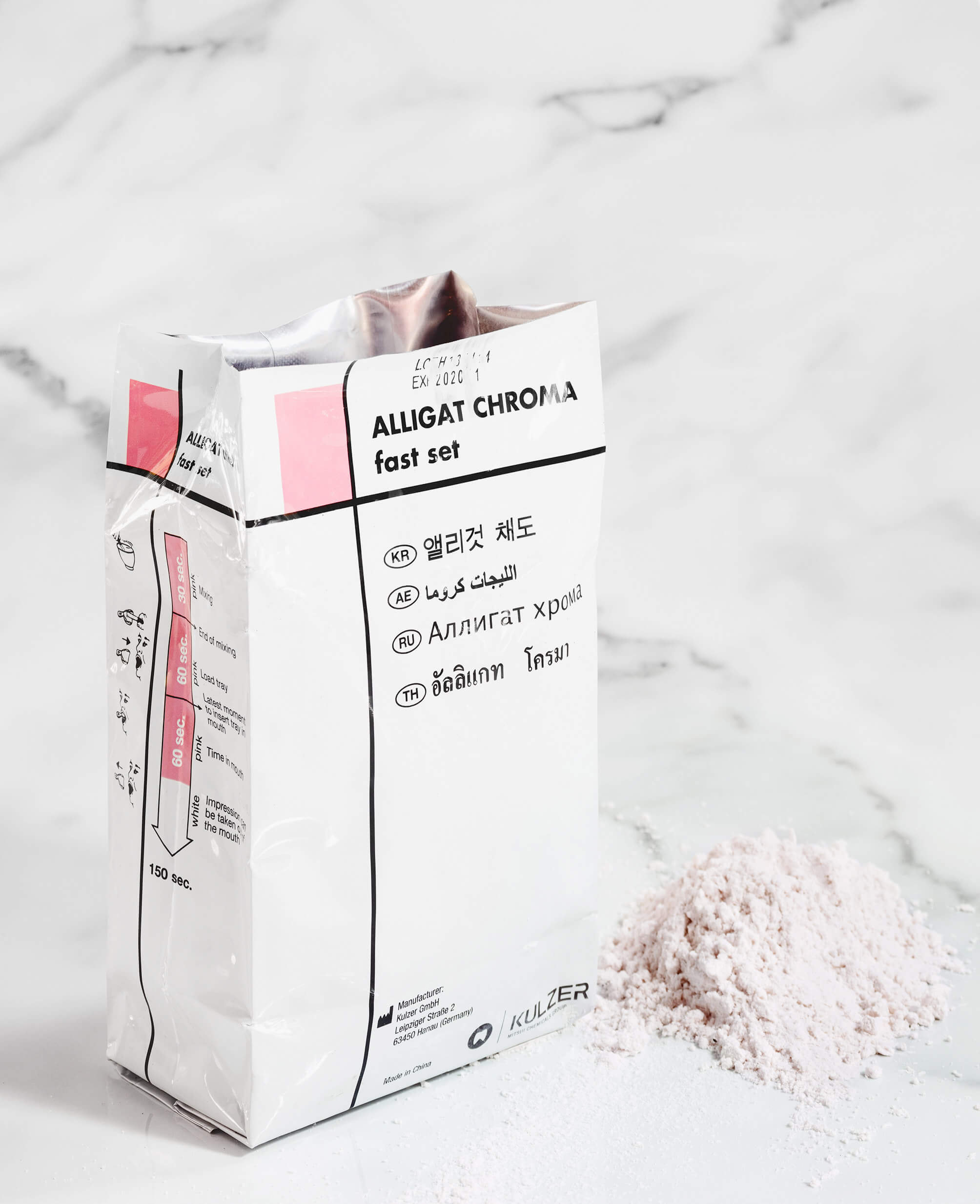
On Mondays, before noon, I go to the supermarket with my two-year-old son. After passing the lasagnes, the loaves of bread and the fruit and vegetables, we make a short stop at the aquarium with the lobsters. Around New Year, there are two of them.
After we’ve paid for the groceries and have put them in the car, we walk into the pet shop. We look at the parrots (Jacques, Louis and Marie-José), the rabbits, the guinea pigs, the assorted caged birds and the fish and turtles. He’s very fond of the Cyphotilapia Frontosa Burundi. He calls them zebras. They hail from Lake Tanganyika, the label says. It’s the second-oldest freshwater lake, the second-largest by volume and the second-deepest. The pet shop has adorned their aquarium with a scene of ocean waste.
In an effort to avert guilt, I look for something cheap and more or less useful to buy: birdseed, a snack for the neighbour’s cat, a comb for his grandparent’s Labrador, etc.
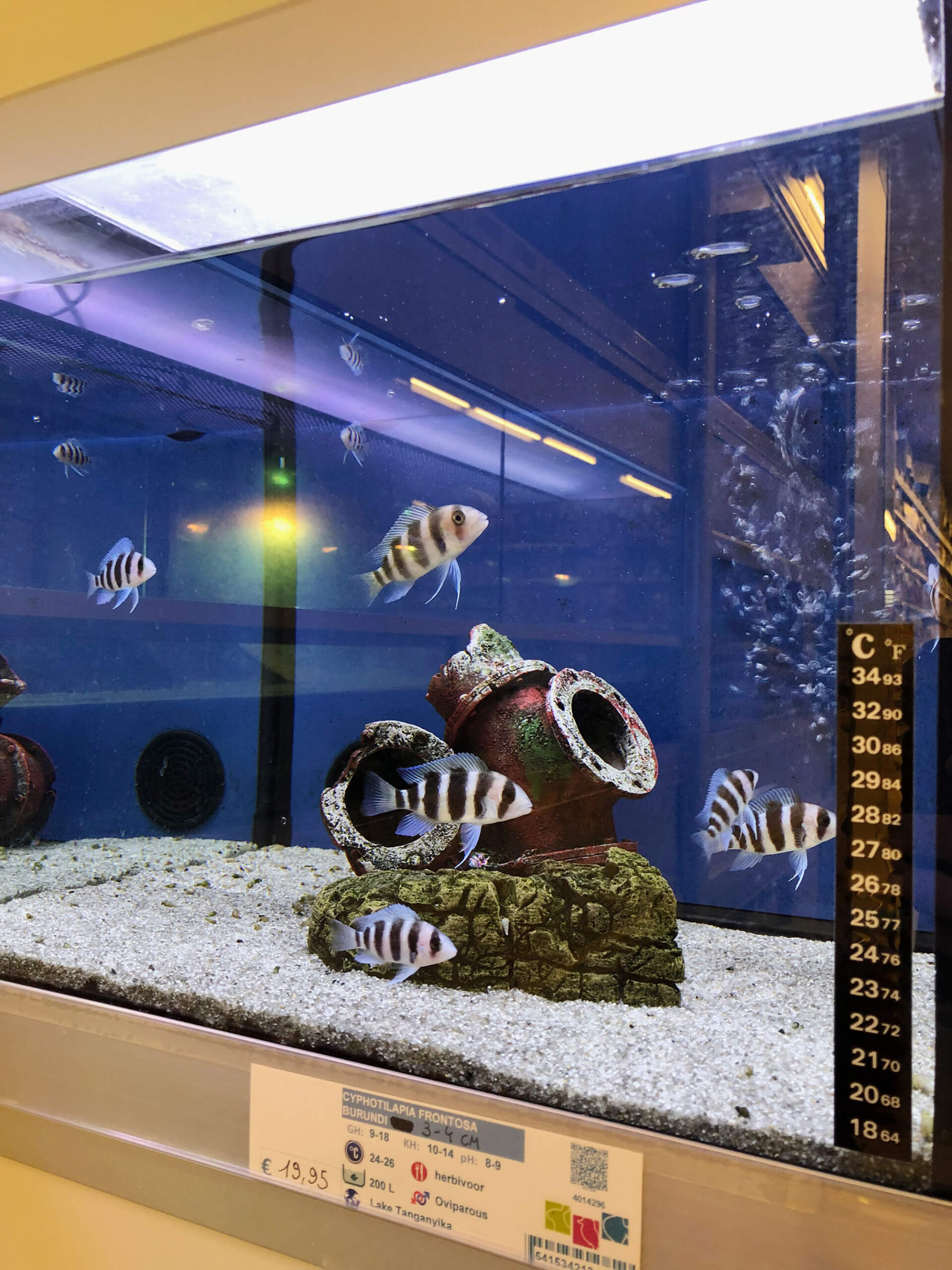
Article 75 of the Royal Decree containing general regulations for road traffic and the use of public roads, published in Het Belgisch Staatsblad on 9 December 1975, lists the rules for longitudinal markings indicating the edge of the roadway.
According to 75.1, there are two types of markings that indicate the actual edge of the roadway: a white, continuous stripe and a yellow interrupted line. The former is mainly used to make the edge of the roadway more visible; the latter indicates that parking along it is prohibited.
In 75.2, the decree focuses on markings that indicate the imaginary edge of the roadway. Only a broad, white, continuous stripe is permitted for this purpose. The part of the public road on the other side of this line is reserved for standing still and parking, except on motorways and expressways.
https://wegcode.be/wetteksten/secties/kb/wegcode/262-art75

As the hours passed, and while clouds continuously kept us from seeing stars and planets, we started to photograph the set-up used to launch this website. To highlight the umbrella that protected the gear from the unpredictable bursts of rain, we used a flashlight: during the thirty second long exposure, it was lit for two seconds. This proved to be enough to give the whole the feel of an untampered, realistic view. Meanwhile, the website was in all likelihood streaming a grey haze, as the telescope was pointed to the fleeting clouds and gradually spinning along with the earth’s movement to keep track of the same invisible celestial bodies. As we returned to the base, planet Jupiter had become visible to the naked eye.
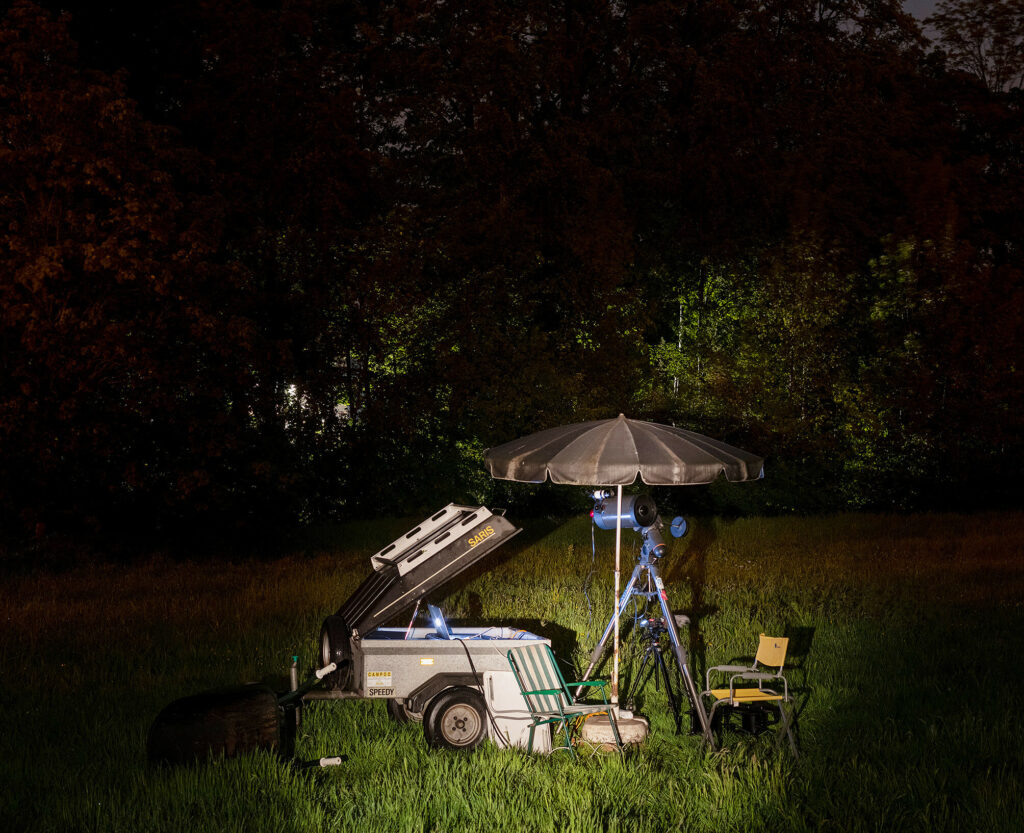
In another exposure of the same length, we left the flashlight on for approximately eight seconds and pointed the beam a bit lower.

In Veurne, at the bakery museum, old speculaas moulds are presented in an almost religious fashion. Looking at these wooden blocks, they appear to be the negatives to Romanesque sculptures.
How does it feel to be conserved and showcased when your nature is to be a tool? What would it mean to re-use them, to fill those empty moulds, to shape something new without altering the matrix, to project what it would be like, to try out recipes and different baking, to learn from it and enjoy the results together? What scenes are even depicted? We lost part of their meaning, we could dig further, browse the books, ask our grandparents and collectively invent whatever narrative they might hold.
Clementine Vaultier’s interests, although trained as a ceramist, are in the warm surroundings of the fire rather than the production it engenders.
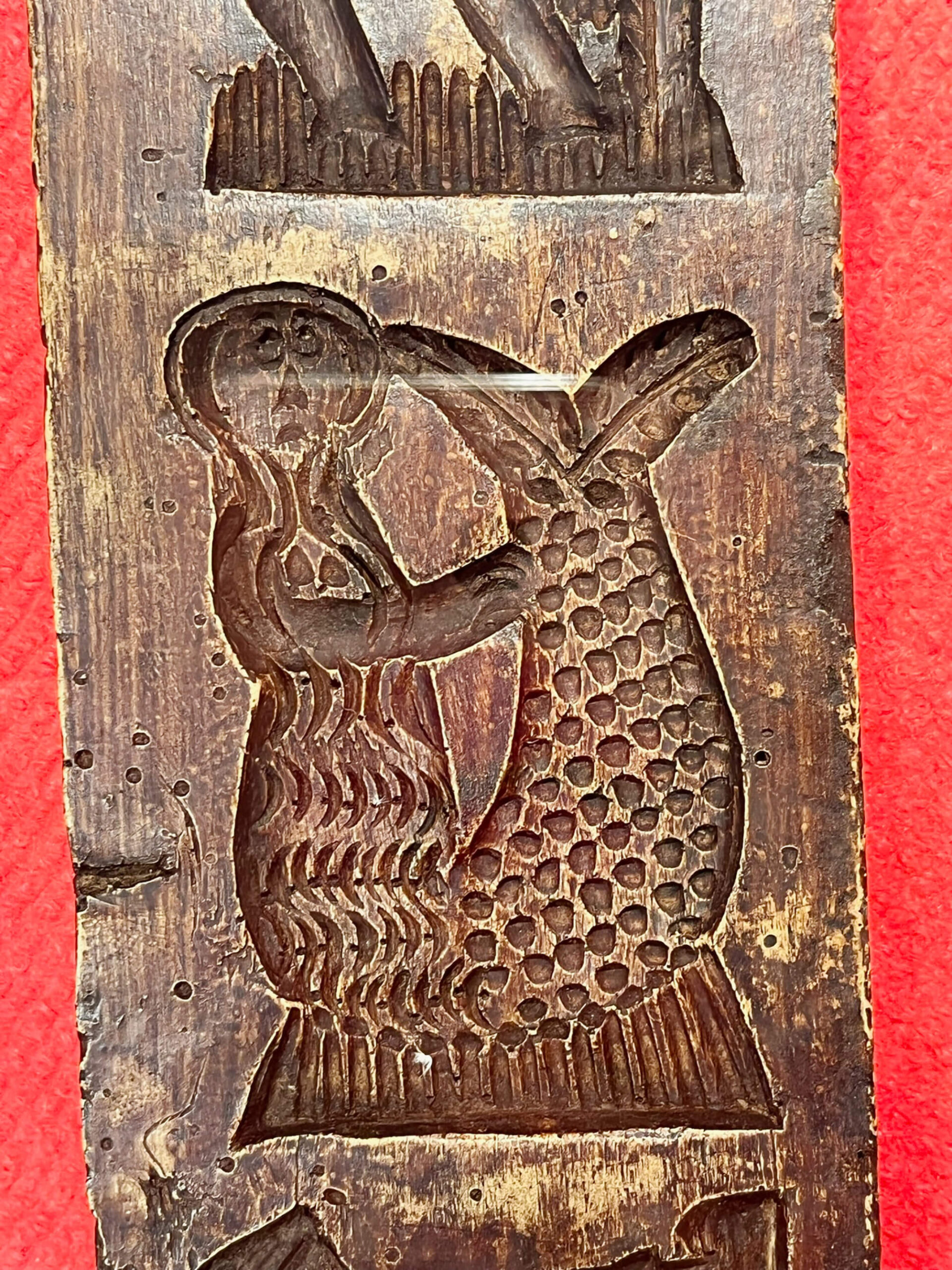
In Six Stories from the End of Representation, James Elkins writes: ‘Astrophysicists are well practised in “cleaning up” photographic plates by adjusting colour and contrast, removing images of dust, correcting aberrations, restoring lost pixels, and balancing uneven background illumination. When it comes to blur, the usual strategy is to specify what counts as “smooth” and what counts as “pointlike,” and then refine the image until it exhibits the required pointlike properties’1. Still, some astronomic images keep a certain amount of blur (although it would be technically possible to delineate them). Elkins continues: ‘blur does not need to be a matter of distance from some hypothetical optimal clarity: it can be a functional scale, independent of the viewer’s notions of clarity and even of the image itself’2.
On the night of 22 November 2021, I join John Sussenbach in his backyard while he captures Neptune.
He invites me to join him and his wife for dinner. A prayer. Soup and bread. The images he makes, he explains, are complex from a temporal point of view. The light coming from Neptune has travelled for four hours before it reaches us. Moreover, these images are not photographs of a singular moment, but stacked frames of a video-recording. In doing so, he can, to some extent, eliminate the effects of a bad ‘seeing’: the negative effect atmospheric turbulence has on the light that reaches the telescope.
A bright dot is jumping around on his laptop’s screen. ‘That’s Neptune’, he says. With his index finger he follows the dot. ‘That’s the bad seeing. That’s the unrest.’
The next day I send him the photograph I took of him standing on his ladder, dangerously placed on the edge of the tarp covering his pool. ‘Nice to see the open star cluster Pleiades in your photograph’, he replies. He attaches the image he made that night: ‘If there would have been a clear storm on Neptune, it would have shown’.
Image by John Sussenbach. 22 November 2021 19.00 UT North up
C14 f/11 and ASC462MC camera plus ADC, Houten (NL)
Elkins, J. Six Stories from the End of Representation. Images in Painting, Photography, Astronomy, Microscopy, Particle Physics, and Quantum Mechanics, 1980-2000. Stanford: Stanford University Press, 2008, 59.
Ibid., 62-63.
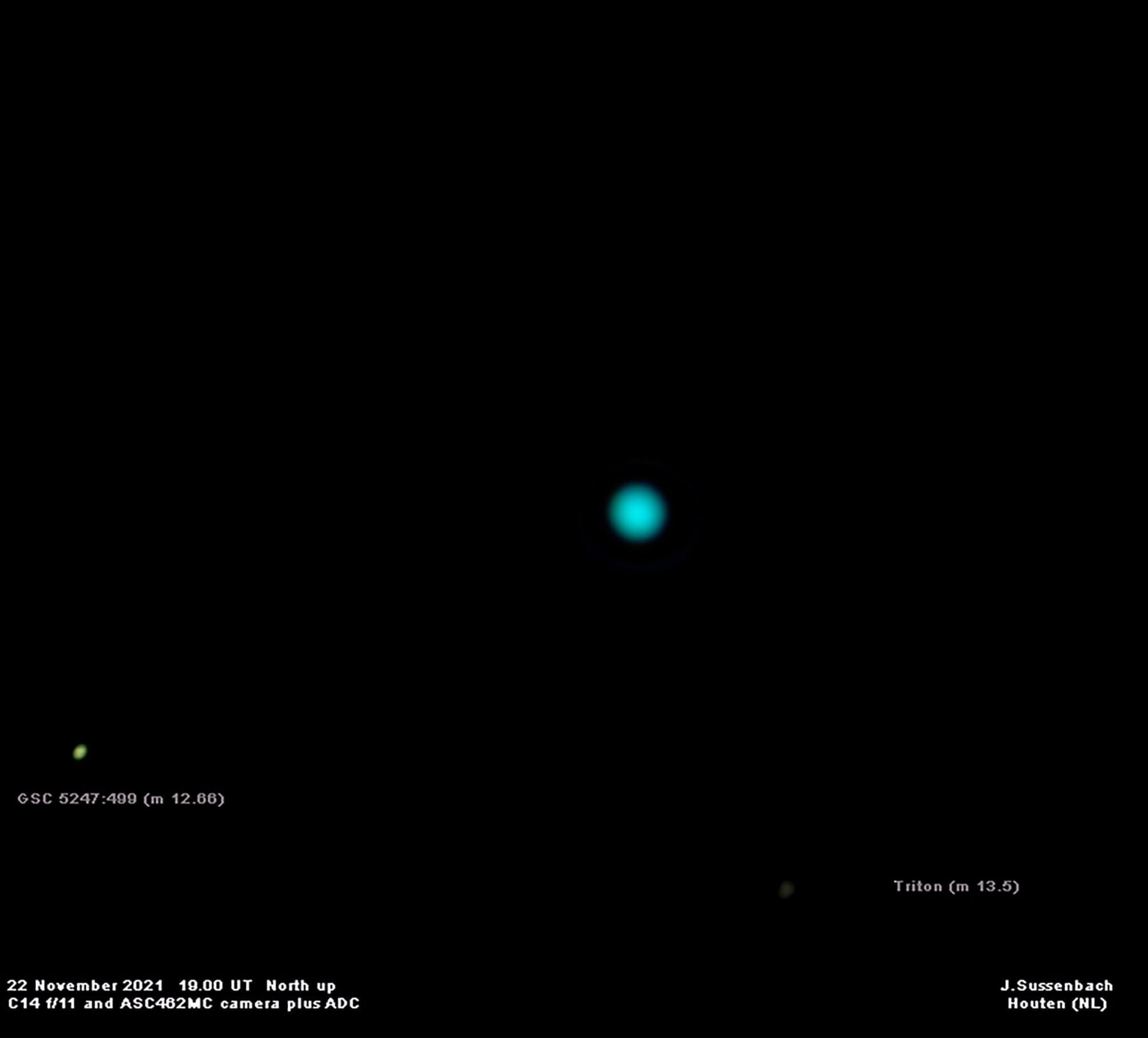

During the night, both of us get unwell. One of us is shaking, intensely and relentlessly. The windows are open. For minutes that seem to be hours, it feels like it’s freezing. We get extra blankets. Then, it gets too hot.
One of us dreams about coccodrillos. It starts out with a single animal, like the one we saw in the National Archaeological Museum, escaping from an aquarium, and ends with lots of little ones crawling all over the place. It’s impossible to know how many have escaped.
The other dreams about seismologist Luigi Palmieri’s unfortunate assistant and his family’s quest to redeem his good name. To deprive him of the burden and guilt set upon him by Luigi Palmieri’s report of the 1872 eruption of Vesuvius, the assistant’s offspring were building a monument just below the observatory in which their great-grandfather fell asleep. The monument was permanently, and continuously, unfinished.
We both dream of hearing fireworks in Naples.
In the morning, we’re slightly alarmed that we both got sick and feverish at the same instant. It’s the middle of January, and the weather has been summerlike all week. A gentle morning breeze flies in from the Neapolitan bay while we wait for the bus to take us to the airport.
First published as part of De Cleene De Cleene. ‘Amidst the Fire, I Was Not Burnt’, Trigger (Special issue: Uncertainty), 2. FOMU/Fw:Books, 25-30

He’s wearing a digital watch. It looks like a Casio. It’s impossible to read the time, no matter whether you are studying the high-resolution scan of the negative or the negative itself, with the aid of a loupe and lightbox.
The device had a stopwatch function. When we were around eight and ten, we used to compete in trying to start and stop the stopwatch in the shortest possible interval. The smaller the gap, the closer to zero. Sometimes he would also have a try. We once managed to get it down to 00:00:00:03. Neither of us dared to press ‘reset’ and try again.
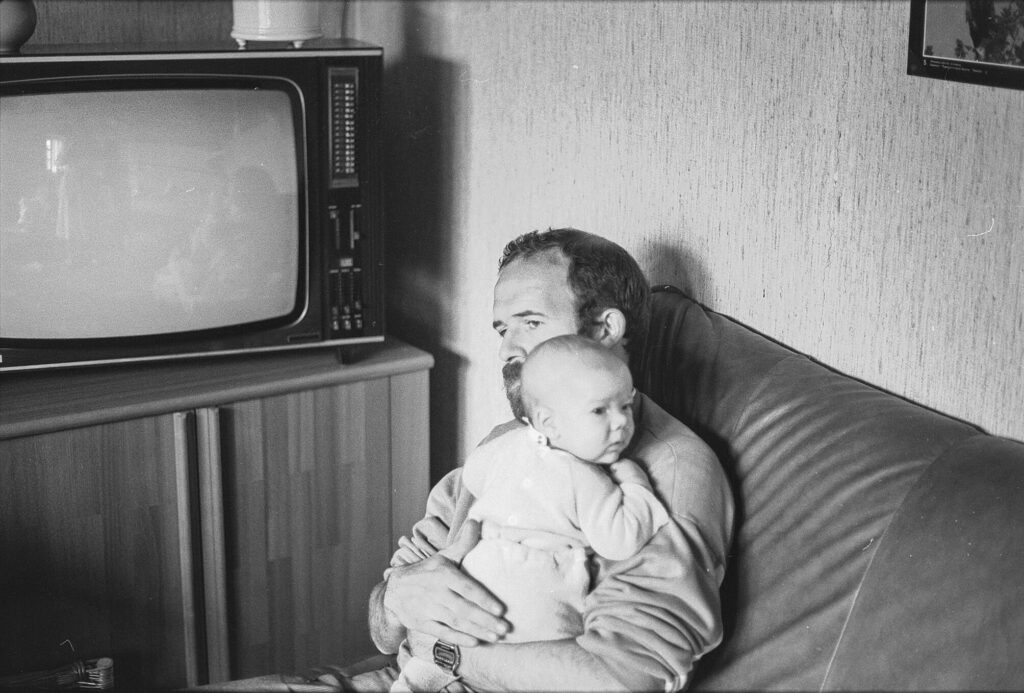
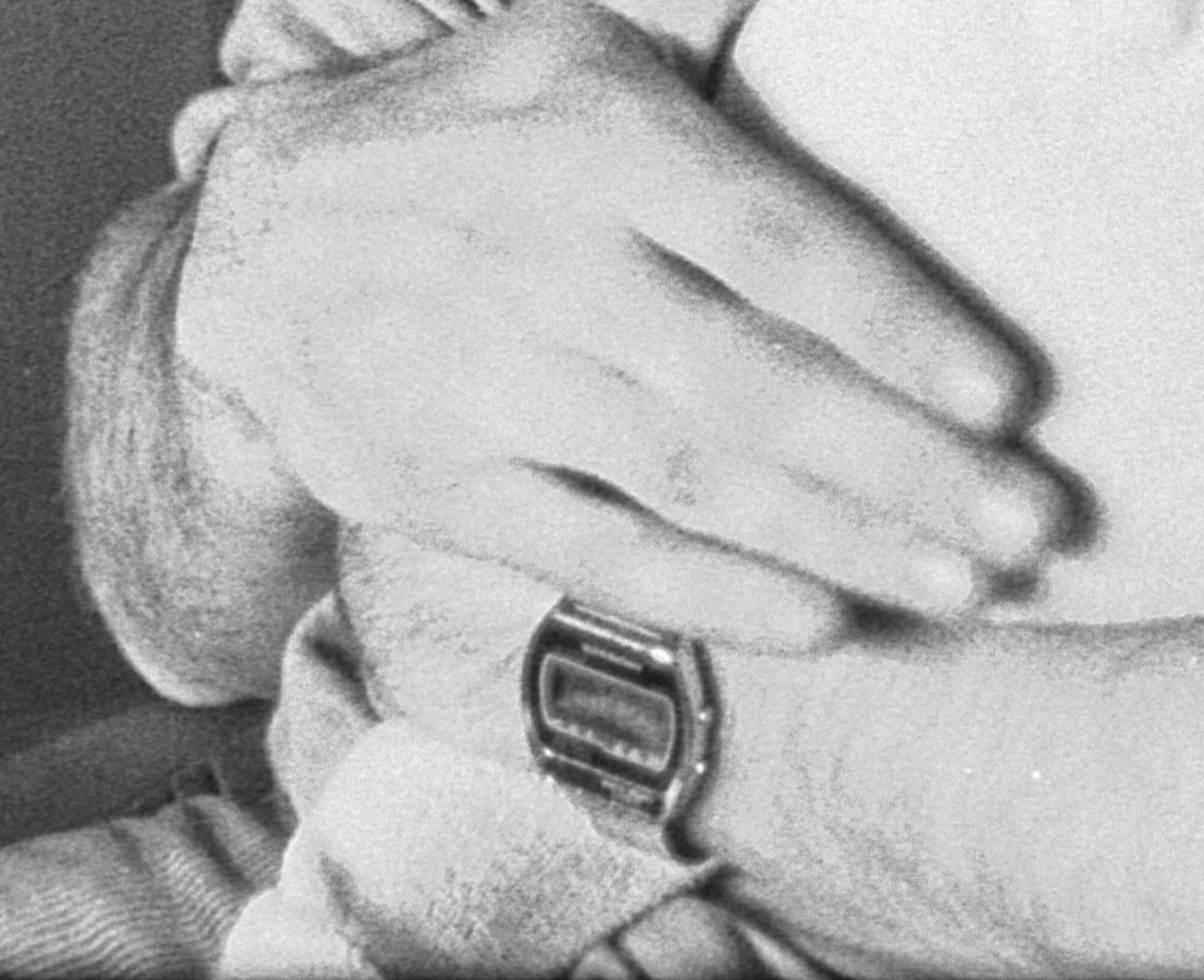
During the night, both of us get unwell. One of us is shaking, intensely and relentlessly. The windows are open. For minutes that seem to be hours, it feels like it’s freezing. We get extra blankets. Then, it gets too hot.
One of us dreams about coccodrillos. It starts out with a single animal, like the one we saw in the National Archaeological Museum, escaping from an aquarium, and ends with lots of little ones crawling all over the place. It’s impossible to know how many have escaped.
The other dreams about seismologist Luigi Palmieri’s unfortunate assistant and his family’s quest to redeem his good name. To deprive him of the burden and guilt set upon him by Luigi Palmieri’s report of the 1872 eruption of Vesuvius, the assistant’s offspring were building a monument just below the observatory in which their great-grandfather fell asleep. The monument was permanently, and continuously, unfinished.
We both dream of hearing fireworks in Naples.
In the morning, we’re slightly alarmed that we both got sick and feverish at the same instant. It’s the middle of January, and the weather has been summerlike all week. A gentle morning breeze flies in from the Neapolitan bay while we wait for the bus to take us to the airport.
First published as part of De Cleene De Cleene. ‘Amidst the Fire, I Was Not Burnt’, Trigger (Special issue: Uncertainty), 2. FOMU/Fw:Books, 25-30

The river swells and eventually overflows, causing the death of six people and extensive damage: washed away bridges, damaged homes, submerged factories, destroyed food stocks, heavily eroded roads and paths.
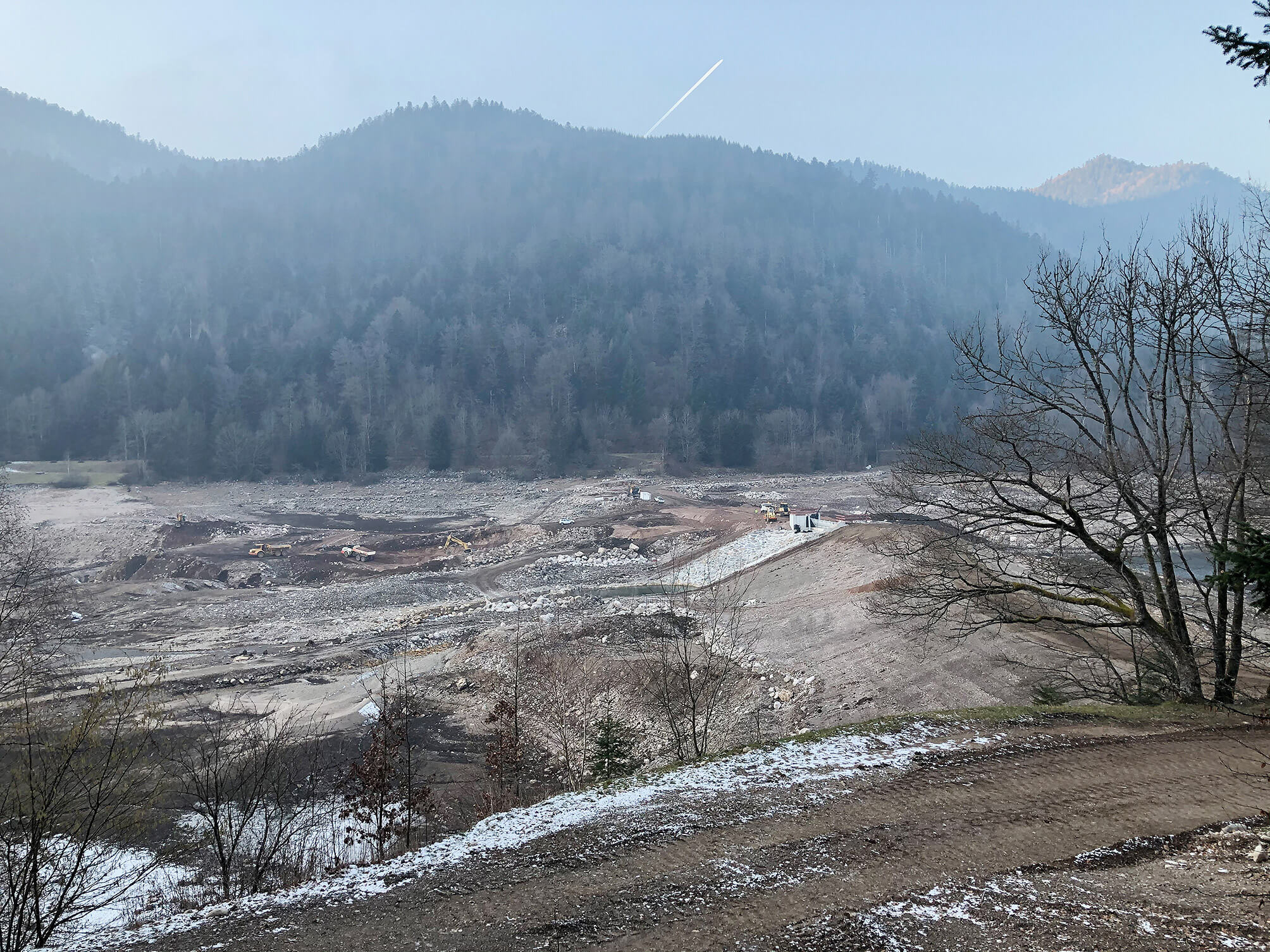
In Six Stories from the End of Representation, James Elkins writes: ‘Astrophysicists are well practised in “cleaning up” photographic plates by adjusting colour and contrast, removing images of dust, correcting aberrations, restoring lost pixels, and balancing uneven background illumination. When it comes to blur, the usual strategy is to specify what counts as “smooth” and what counts as “pointlike,” and then refine the image until it exhibits the required pointlike properties’1. Still, some astronomic images keep a certain amount of blur (although it would be technically possible to delineate them). Elkins continues: ‘blur does not need to be a matter of distance from some hypothetical optimal clarity: it can be a functional scale, independent of the viewer’s notions of clarity and even of the image itself’2.
On the night of 22 November 2021, I join John Sussenbach in his backyard while he captures Neptune.
He invites me to join him and his wife for dinner. A prayer. Soup and bread. The images he makes, he explains, are complex from a temporal point of view. The light coming from Neptune has travelled for four hours before it reaches us. Moreover, these images are not photographs of a singular moment, but stacked frames of a video-recording. In doing so, he can, to some extent, eliminate the effects of a bad ‘seeing’: the negative effect atmospheric turbulence has on the light that reaches the telescope.
A bright dot is jumping around on his laptop’s screen. ‘That’s Neptune’, he says. With his index finger he follows the dot. ‘That’s the bad seeing. That’s the unrest.’
The next day I send him the photograph I took of him standing on his ladder, dangerously placed on the edge of the tarp covering his pool. ‘Nice to see the open star cluster Pleiades in your photograph’, he replies. He attaches the image he made that night: ‘If there would have been a clear storm on Neptune, it would have shown’.
Image by John Sussenbach. 22 November 2021 19.00 UT North up
C14 f/11 and ASC462MC camera plus ADC, Houten (NL)
Elkins, J. Six Stories from the End of Representation. Images in Painting, Photography, Astronomy, Microscopy, Particle Physics, and Quantum Mechanics, 1980-2000. Stanford: Stanford University Press, 2008, 59.
Ibid., 62-63.


On Mondays, before noon, I go to the supermarket with my two-year-old son. After passing the lasagnes, the loaves of bread and the fruit and vegetables, we make a short stop at the aquarium with the lobsters. Around New Year, there are two of them.
After we’ve paid for the groceries and have put them in the car, we walk into the pet shop. We look at the parrots (Jacques, Louis and Marie-José), the rabbits, the guinea pigs, the assorted caged birds and the fish and turtles. He’s very fond of the Cyphotilapia Frontosa Burundi. He calls them zebras. They hail from Lake Tanganyika, the label says. It’s the second-oldest freshwater lake, the second-largest by volume and the second-deepest. The pet shop has adorned their aquarium with a scene of ocean waste.
In an effort to avert guilt, I look for something cheap and more or less useful to buy: birdseed, a snack for the neighbour’s cat, a comb for his grandparent’s Labrador, etc.
